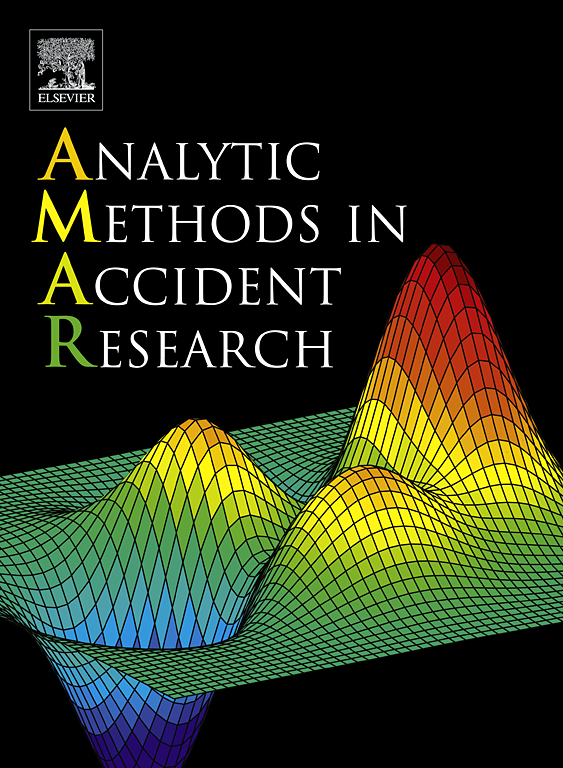Time-dependent effect of advanced driver assistance systems on driver behavior based on connected vehicle data
IF 12.6
1区 工程技术
Q1 PUBLIC, ENVIRONMENTAL & OCCUPATIONAL HEALTH
引用次数: 0
Abstract
This paper proposes a novel functional data analysis approach to investigate the time-dependent effect of advanced driver assistance systems (ADAS), specifically forward collision warnings, on driver speed reduction behavior. Existing aggregate measures compress temporal information within driver behavior profiles and fail to explicitly reveal the temporal dependency of such effect. With the proposed approach, the functional representation method is adopted to capture the underlying driver behavior in response to warning messages and address issues of irregularly spaced observations and measurement errors; the results of the functional principal component analysis with the bootstrap-enhanced Kaiser-Guttman method reveal important patterns in driver response behaviors; and a nonparametric functional varying coefficient regression model, considering vehicle initial motions and drivers’ acceleration styles, is established. This regression model utilizes coefficient functions to estimate the time-dependent effect of ADAS. The proposed approach is evaluated based on the New York City connected vehicle dataset using forward collision warning event records. The results suggest that the treatment effect of the warning messages is time-dependent, initially increasing before progressively decreasing over time. Driver responses can be decomposed into several phases at the 95 % confidence level, including reaction time (1.3 s), brake adjustment time (1.3 s), progressive braking duration (2.7 s), and effective treatment duration (4.0 s). The time-dependent bootstrap confidence interval confirms driver heterogeneity in these distinct phases. The proposed functional data analysis approach can serve as a paradigm for quantifying the treatment effect of other ADAS applications. The findings can support the improvements of ADAS design and the development and calibration of driver behavior models accounting for ADAS.
基于车联网数据的高级驾驶辅助系统对驾驶员行为的时变影响
本文提出了一种新的功能数据分析方法来研究先进驾驶辅助系统(ADAS)对驾驶员减速行为的时间依赖性影响,特别是前向碰撞警告。现有的聚合度量压缩了驾驶员行为概况中的时间信息,并且不能明确地揭示这种影响的时间依赖性。该方法采用函数表示方法捕捉驾驶员响应警告信息的潜在行为,并解决观测间隔不规则和测量误差的问题;基于自举增强的Kaiser-Guttman方法的功能主成分分析结果揭示了驾驶员响应行为的重要模式;建立了考虑车辆初始运动和驾驶员加速方式的非参数变系数函数回归模型。该回归模型利用系数函数来估计ADAS的时变效应。基于纽约市互联汽车数据集,使用前向碰撞预警事件记录对该方法进行了评估。结果表明,警告信息的治疗效果是时间依赖性的,最初增加,然后随着时间的推移逐渐减少。在95%的置信水平下,驾驶员的反应可以分解为几个阶段,包括反应时间(1.3 s)、制动调整时间(1.3 s)、渐进制动时间(2.7 s)和有效处理时间(4.0 s)。随时间变化的自举置信区间证实了驾驶员在这些不同阶段的异质性。所提出的功能数据分析方法可以作为量化其他ADAS应用的治疗效果的范例。研究结果可为ADAS设计的改进以及考虑ADAS的驾驶员行为模型的开发和校准提供支持。
本文章由计算机程序翻译,如有差异,请以英文原文为准。
求助全文
约1分钟内获得全文
求助全文
来源期刊

Analytic Methods in Accident Research
Multiple-
CiteScore
22.10
自引率
34.10%
发文量
35
审稿时长
24 days
期刊介绍:
Analytic Methods in Accident Research is a journal that publishes articles related to the development and application of advanced statistical and econometric methods in studying vehicle crashes and other accidents. The journal aims to demonstrate how these innovative approaches can provide new insights into the factors influencing the occurrence and severity of accidents, thereby offering guidance for implementing appropriate preventive measures. While the journal primarily focuses on the analytic approach, it also accepts articles covering various aspects of transportation safety (such as road, pedestrian, air, rail, and water safety), construction safety, and other areas where human behavior, machine failures, or system failures lead to property damage or bodily harm.
 求助内容:
求助内容: 应助结果提醒方式:
应助结果提醒方式:


